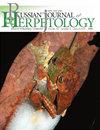论Murree山蛙的地理分布、饮食和保护(Stoliczka, 1872)
IF 0.9
4区 生物学
Q3 ZOOLOGY
引用次数: 0
摘要
Murree Hills蛙,Nanorana vicina,是南亚研究不足的无尾蛙物种之一。我们假设Murree Hills蛙在繁殖季节和非繁殖季节的饮食不同。我们发现,该物种在巴基斯坦的地理范围比报道的要窄。它发生在穆里县(旁遮普省拉瓦尔品第区)、阿博特阿巴德区(开伯尔-普赫图赫瓦省)以及庞奇和巴格区(阿扎德-查谟和克什米尔)。在繁殖季节,我们从胃内容物中回收了12个分类群。最常见的食物包括鞘翅目(60%,恒定)和膜翅目(40%,次要)。鞘翅目食物对胃内容物体积(ml)的贡献最大,为0.06,其次为膜翅目0.05和等翅目0.05。青蛙对鞘翅目动物表现出次要的食物偏好,偶尔也会对其他食物表现出偏好。我们在非繁殖季节记录了10种食物。最常见的食物包括鞘翅目(45%,次要)、膜翅目(40%,次要)和直翅目(35%,次要)。鞘翅目食物对胃内容物体积(ml)贡献最大,为0.12,其次为直翅目0.11。该物种对鞘翅目、膜翅目和直翅目表现出次要的食物偏好,偶尔对其他食物表现出偏好。繁殖季节和非繁殖季节的食物分类群没有显著差异。我们已经报告了该物种面临的主要威胁,并提出了研究、保护和管理方案。本文章由计算机程序翻译,如有差异,请以英文原文为准。
On Geographic Range, Diet and Conservation of Endemic Murree Hills Frog Nanorana vicina (Stoliczka, 1872)
Murree Hills Frog, Nanorana vicina, is one of the under studied anuran species of South Asia. We hypothesized that the diet of Murree Hills Frog differed during breeding and non-breeding seasons. We found that the geographic range of the species in Pakistan is narrower than reported. It occurs in Tehsil Murree (District Rawalpindi, Province Punjab), District Abbotoabad (Province Khyber Pakhtunkhwa) and Districts Poonch and Bagh (Azad Jammu and Kashmir). We recovered 12 taxa from stomach contents during the breeding season. The most frequent food items included Coleopterans (60%, constant) and Hymenopterans (40%, secondary). The food items from order Coleoptera contributed the most in the stomach content volume (ml) 0.06, followed by Hymenoptera 0.05, and Isoptera 0.05. The frogs showed secondary degree of food preference for Coleopterans and occasional for other food items. We recorded ten food items during non-breeding season. The most frequent food items included Coleopterans (45%, secondary), Hymenopterans (40%, secondary) and Orthopterans (35%, secondary). The food items from order Coleoptera contributed the most in the stomach content volume (ml) 0.12, followed by Orthoptera 0.11. The species showed secondary degree of food preference for Coleopterans, Hymenopterans and Orthopterans and occasional for other food items. The food item taxa during breeding and non-breeding seasons did not differ significantly. We have reported major threats to the species and suggested research, conservation and management options.
求助全文
通过发布文献求助,成功后即可免费获取论文全文。
去求助
来源期刊

Russian Journal of Herpetology
ZOOLOGY-
CiteScore
1.70
自引率
0.00%
发文量
29
期刊介绍:
Russian Journal of Herpetology is an international multi-disciplinary journal devoted to herpetology. Russian Journal of Herpetology accepts original papers on ecology, behavior, conservation, systematics, evolutionary morphology, paleontology, physiology, cytology and genetics of amphibians and reptiles.
Types of Contributions:
-original papers
-invited or contributed reviews on specific topics
-short communications on topics of immediate interest, new methods and ideas in progress
-notices of meetings, symposia, and short courses
-book reviews
 求助内容:
求助内容: 应助结果提醒方式:
应助结果提醒方式:


